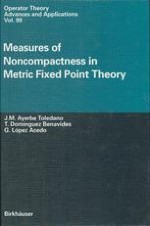What is clear and easy to grasp attracts us; complications deter David Hilbert The material presented in this volume is based on discussions conducted in peri odically held seminars by the Nonlinear Functional Analysis research group of the University of Seville. This book is mainly addressed to those working or aspiring to work in the field of measures of noncompactness and metric fixed point theory. Special em phasis is made on the results in metric fixed point theory which were derived from geometric coefficients defined by means of measures of noncompactness and on the relationships between nonlinear operators which are contractive for different measures. Several topics in these notes can be found either in texts on measures of noncompactness (see [AKPRSj, [BG]) or in books on metric fixed point theory (see [GK1], [Sm], [Z]). Many other topics have come from papers where the authors of this volume have published the results of their research over the last ten years. However, as in any work of this type, an effort has been made to revise many proofs and to place many others in a correct setting. Our research was made possible by partial support of the D.G.I.C.y'T. and the Junta de Andalucia.
